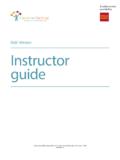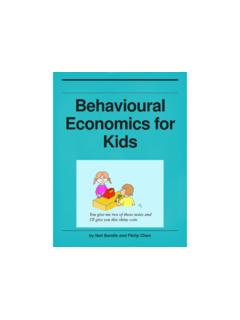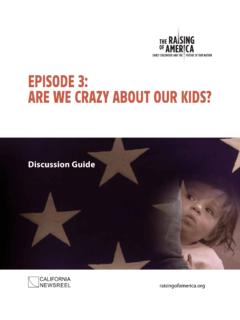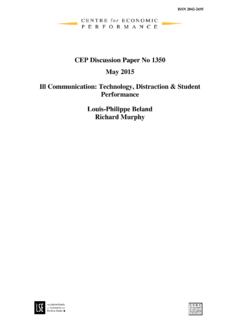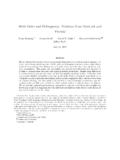Transcription of Kids' Instructor Guide - Hands on Banking®
1 Instructor guideKids version 2003, 2012 Wells Fargo Bank, All rights reserved. Member FDIC. ECG-714394 Hands on Banking Instructor Guide kids Version (Grades 4 and 5) Table of Contents Introduction .. 3 How to Use This Guide .. 5 You and Your Money .. 8 Section 1: The Meaning of Money .. 9 Section 2: Earnings .. 10 Earning Power Worksheet ..11 Section 3: What Banks Do .. 14 Teaching Tips .. 17 Budgeting .. 20 Section 1: Needs versus Wants .. 21 Personal Budget Section 2: Budgets .. 24 Shopping With a Budget Worksheet ..25 Build Your Own Budget Worksheet ..30 Teaching Tips .. 34 Savings and Checking Guide .. 35 Section 1: Savings Accounts .. 36 Depositing money in a savings account.
2 37 Savings Deposit Worksheet ..38 Section 2: Savings Withdrawals .. 40 Savings Withdrawal Worksheet ..41 Section 3: Keeping Track of Your Savings .. 43 Savings Register Worksheet ..44 Section 4: Writing a Check .. 46 Writing a Check Worksheet ..47 Section 5: Keeping Track of Your Checking 50 Check Register Worksheet ..51 Section 6: The Concept of Balancing a Checking Account .. 53 Teaching Tips .. 55 Credit and You .. 60 Section 1: Credit and Interest .. 61 Credit: The importance of personal responsibility ..61 Credit cards ..62 Loans ..62 Purchasing Worksheet ..63 Teaching Tips .. 65 Assessment .. 67 Introduction ..67 Table of Contents (continued) Assessment Worksheet ..68 Additional Student Activities.
3 74 Proposing a Budget .. 74 Money Word Search ..75 Money Match ..78 Money Bingo ..81 Money Word Jumble ..82 Growing Your Money ..84 Additional Financial Literacy References for kids * .. 86 Glossary .. 88 Hands On Banking Teacher s Guide 2003, 2012 Wells Fargo Bank, All rights reserved. Member FDIC kids Introduction 3 Introduction The Hands on Banking program is an interactive financial-literacy curriculum for students grades 4-12 and adults. This teacher s Guide is designed for the kids (grades 4 and 5) curriculum of the program. The Hands on Banking program was developed to teach both the basics of good money management and the skills needed to create a brighter financial future.
4 The lessons examine financial concepts and decision-making through illustration, real-life problems, and mathematical computation. The curriculum is relevant to students lives, and is designed to support their financial success. This fun and innovative program was developed by Wells Fargo as a free community service. It is intended for educational purposes only and contains no commercial content. The Hands on Banking program is available free of charge in both English and Spanish, both on the Web (at and ) and on CD-ROM. The curriculum is designed for self-paced, individual learning or for classroom use. This teacher s Guide is designed to be used alone or as an adjunct to the online program.
5 Educational standards The lessons in this program adhere to the following mathematics and financial literacy standards: National Council of Teachers of Mathematics (Principles and Standards for School Mathematics, 2000) National Council of Economic Education and the National Association of Economics Educators and the Foundation for Teaching Economics, Voluntary National Content Standards in Economics (1997) JumpStart Coalition for Personal Financial Literacy, National Standards in K-12 Personal Finance Education (2007) The No Child Left Behind Act is a federal law designed to improve the academic achievement of all students, particularly those who are minorities, disabled, economically disadvantaged, or have limited English proficiency.
6 The Act requires teachers of mathematics to provide all students with equal opportunities to excel and the mathematical skills and knowledge they need to actively participate in American society. Consistent with the objectives of the No Child Left Behind Act, the Hands on Banking / El futuro en tus manos curriculum and supplemental materials for grade levels 4-12 are aligned with both state and national educational standards for mathematics, reading, and economics. Teachers are encouraged to integrate the content into other lesson plans, and use the curriculum as a springboard to address real-life situations. Please refer to your own state, local, district, or school standards to determine the appropriateness of the lessons for your students.
7 Curriculum overview The online kids curriculum of the Hands on Banking program is divided into four units, plus an assessment. Each unit contains multiple lessons. The teacher s Guide condenses each online unit s lessons into a smaller number of sections. The lessons in this Guide contain activity worksheets for you to use with your students. This curriculum is designed to be presented in the given lesson sequence. However, depending on what is appropriate for your students, you may wish to establish your own sequence. Problem solving is woven into all of the program s units. Students apply both their understanding of basic banking concepts as well as strategies to solve challenging problems in different contexts.
8 To be successful with the Hands on Banking curriculum, students should be able to: Perform basic functions on a calculator Read proficiently at a level commensurate with their grade level Follow basic written and oral directions, and readily understand oral dialogue Because students mathematical skills vary, teachers should review the problems in this Guide before having students use the Hands on Banking Web site. To request a free CD-ROM To request a CD-ROM for your classroom, please contact us via email at The CD-ROM contains both the English and Spanish versions of the program for all age groups. There is no charge for small quantities of the CD-ROM. Please call for information regarding high-volume requests.
9 Please allow two weeks for delivery. Hands On Banking Teacher s Guide 2003, 2012 Wells Fargo Bank, All rights reserved. Member FDIC kids Introduction 4 Your thoughts are welcome We welcome your comments and suggestions for future versions of the Hands on Banking curriculum and this teacher s Guide . Please contact us via email at Thank you for sharing these valuable financial literacy programs with students and adults in our communities. As a teacher, your training and guidance will provide others with the knowledge and skills they need for a brighter financial future! Hands On Banking Teacher s Guide 2003, 2012 Wells Fargo Bank, All rights reserved.
10 Member FDIC 5 kids How To Use This Guide How to Use This Guide The purpose of this teacher s Guide is to support the effective presentation of the Hands on Banking curriculum in your classroom. As a first step, we strongly encourage you to review the program online (at and Even if your students will not be using computers at school, gaining familiarity with the program will help you present it more effectively. Five ways this Guide can help you This teacher s Guide is designed to be used alone or as an adjunct to the online program. If you re a teacher or group leader, this Guide can help you in five ways: 1. Gain familiarity with the program: Reviewing this Guide is a convenient way to familiarize yourself with the kids curriculum if you do not have ready access to a computer or the Internet.)
